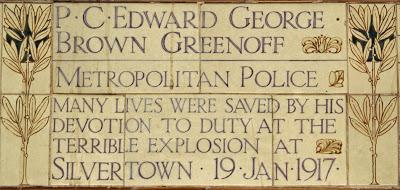
On 19 January 1917 at 6.52pm, the Brunner Mond munitions factory explosion claimed the lives of 73 people in Silvertown, east London - the youngest only 4 months old.
During World War I, the former soda crystal factory was turned over to producing TNT explosive, despite being in a densely-populated area. Brunner Mond opposed this use of the factory: according to their head chemist, Dr F A Freeth, 'At the end of every month we used to write to Silvertown to say that their plant would go up sooner or later, and we were told that it was worth the risk to get the TNT.'
When a fire broke out in the melting pot room on 19 January, 50 tons of explosive ignited, destroying the factory and surrounding buildings. The explosion was heard 100 miles away, and burning debris was thrown for miles, starting further fires: a gasholder on Greenwich Peninsula was ignited and threw a huge fireball into the air. Hundreds of people were injured and thousands were left homeless. The exact cause of the fire is not known, but it was probably due to inadequate safety standards. A government report produced after the disaster (but not released until the 1950s) referred to TNT in torn bags and packages with missing stoppers; production and storage were in the same building.
Tragically, a second, much larger (and safer) TNT factory had already been opened; its higher production made the Silvertown factory unnecessary. Nonetheless, the government insisted on keeping it open, with disastrous consequences. The site of the destroyed factory has not been built upon to this day: it is now a car park.
Among the dead was Dr Andreas Angel, an Oxford professor doing voluntary war work as the plant's chief chemist; he was attempting to help put out the fire. Station Officer S Betts and Fireman Yabsley were killed as they prepared their hoses to tackle the blaze, despite knowing the risk of explosion. The Watts Memorial commemorates a further casualty, PC Edward Greenoff, who helped to evacuate the factory. Aware of the imminent danger, he nonetheless remained outside to warn passers-by of the risk of an explosion. When that explosion did take place, the head injuries he suffered proved fatal; he died nine days later, aged 30. He was posthumously awarded the King's Police Medal. At the time of his death, PC Greenoff had an eight-year-old son, Edward, who would later become a police officer himself.
In the words of the Watts Memorial,
P.C. EDWARD GEORGE BROWN GREENOFF - METROPOLITAN POLICE - MANY LIVES WERE SAVED BY HIS DEVOTION TO DUTY AT THE TERRIBLE EXPLOSION AT SILVERTOWN 19 JAN 1917.

